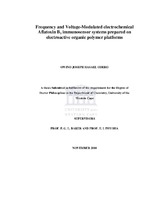Frequency and voltage-modulated electrochemical aflatoxin B1 immunosensor systems prepared on electroactive organic polymer platforms
Abstract
In the presented work, immunosensors for detection of Aflatoxin B1 based on different immobilization platforms were studied. Synthesis of an electroactive hydrogel was also carried out. Aflatoxins are a group of mycotoxins that have deleterious effects on humans and are produced during fungal infection of plants or plant products. Electrochemical immunosensor for the determination of Aflatoxin B1 (AFB1) was developed with anti-aflatoxin B1 antibody immobilized on Pt electrodes modified with polyaniline (PANi) and polystyrene sulphonic acid (PSSA). Impedimetric analysis shows that the electron transfer resistances of Pt/PANi-PSSA electrode, Pt/PANi-PSSA/AFB1-Ab immunosensor and Pt/PANi-PSSA/AFB1-Ab incubated in BSA were 0.458, 720 and 1066 kΩ, respectively. These results indicate that electrochemical impedance spectroscopy (EIS) is a suitable method for monitoring the change in electron-transfer resistance associated with the immobilization of the antibody. Modelling of EIS data gave equivalent circuits which showed that the electron transfer resistance increased from 0.458 kΩ for Pt/PANi-PSSA electrode to 1066 kΩ for Pt/PANi-PSSA/AFB1-Ab immunosensor, indicating that immobilization of the antibody and incubation in BSA introduced an electron transfer barrier. The AFB1 immunosensor had a detection limit of 0.1 mg/L and a sensitivity of 869.6 kΩL/mg.

